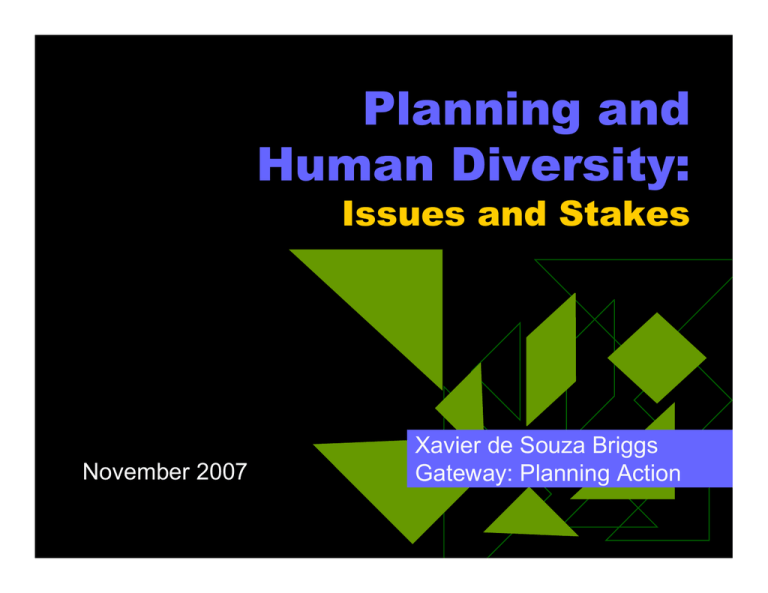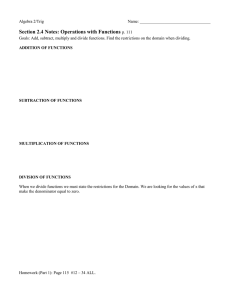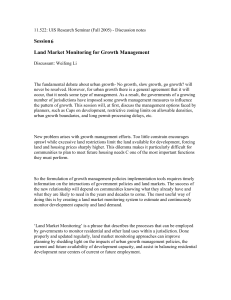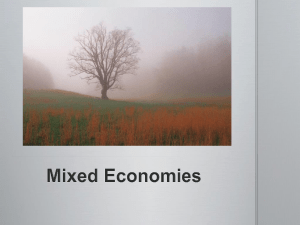Planning and Human Diversity: Issues and Stakes Xavier de Souza Briggs
advertisement

Planning and Human Diversity: Issues and Stakes November 2007 Xavier de Souza Briggs Gateway: Planning Action Today’s agenda Lecture-discussion What are the issues and stakes? What drives population change? Where does—or might—planning fit in? Case discussion (a): Sydney case in Sandercock, “When strangers become neighbors” Case discussion (b): Planning education What’s the issue? Diversity accommodation encounter Resistance Competition conflict Cooperation Tolerance? Melting pots, salad bowls, gumbo? Cultural fusion >< enclaves Preservation ANXIETY change … border-crossings Specialist Areas Integration Cohesion Equality Public Services Citizenship Identity Britishness (From a business card, former staff member of the UK Commission on Racial Equality) Let’s distinguish 1. 2. Diversity as a matter of population make-up (the composition of a project team, organization, neighborhood, region, nation); from Expectations about how that diversity will be handled. The past 40-50 years have brought a revolution, still underway, in both … How make-up shifts Basic demography: components of population change in society (Births minus deaths) In-Migration (+) Natural increase (+ or -) Out-Migration (-) So what’s up with natural increase? In OECD nations, birth rate is way down: Image removed due to copyright restrictions: “Trends in total fertility rates in OECD countries.” Source: OECD, Society at a Glance (2005). Global source: Population Reference Bureau But life expectancy is way up, so … Population pyramids for rapid, slow and zero-growth nations: Kenya, U.S., and Italy. Age structures shape economy, politics, crime, popular culture— everything. Image removed due to copyright restrictions: “Population Pyramids: Kenya, United States, and Italy, 1995.” The Pyramid is “Color Coded” U.S. Age Pyramid, Census 2000 The top is mostly white, the middle and bottom increasingly nonwhite. Migration is the second major driver of shifting make-up U.S. example: The second major wave of immigration is primarily nonEuropean, unlike the first, permitted by (a) policy and driven by (b) economic push/pull factors and (c) political instability outside the recipient country. Immigration by Decade, 1901-98 10,000 1,000s of Persons 9,000 8,000 Immigration Act of 1924 7,000 6,000 Immigration and Nationality Act of 1965 5,000 4,000 3,000 2,000 1,000 0 1901-10 1911-20 1921-30 Source: Bureau of Census 1931-40 1941-50 1951-60 Decade 1961-70 1971-80 1981-90 1991-98 But other OECD nations have much higher foreign-born shares % of total population, selected countries, 2003 Australia (22.8) 25% New Zealand (18.7) Canada (17.9) Germany (12.9) U.S. (12.6) Sweden (12.0) Japan (1.5%) 0% Contrast: Three Cases Unites States Japan Cuba Birth rate In-Migration Relatively high, near replacement Very low < replacement High, regulated with uneven enforcement Very low, exclusionary Relatively low Very low, < replacement regulated Basic Economic Implications Workforce: Who will work to ensure economic prosperity? (workforce make-up and skill building needs) Consumer Demand: Who will the consumers be? (from “niche” to mainstream markets) Social Security: Who will be paying in to the system 30 years from now so that today’s workers can withdraw funds then (as retirees)? Expectations: what about identity? There’s a much longer-run way to look at migration and what it means to be “native” (or not) to a place … The Human Journey: 60,000 Years and Counting Map of Africa showing “Mitochondrial Eve” removed due to copyright restrictions. Source: The Genographic Project, National Geographic Society Migrations Map showing migrations to Asia, Australia, and North America removed due to copyright restrictions. Collisions, Communities, and Histories (Narratives) Photograph and map removed due to copyright restrictions. Machu Picchu, Peru Four “kinds” of Americans 1. 2. 3. 4. Indigenous (“American Indian”) Settlers Slaves Immigrants With battles over who is “native” or “mainstream,” how to handle history in the present day. Photograph of indigenous Americans removed due to copyright restrictions. Assimilation or Convergence? Model 1: Assimilation Model 2: Convergence Fixed boundary, newcomers and natives move in (or not). See Alba and Nee, Remaking the American Mainstream (2003) Fluid boundary (what’s mainstream shifts), groups cross that boundary (or not). Identity and Nationhood Photograph removed due to copyright restrictions. What makes someone “French”? Born in Senegal, Semou Diouf, 50, has spoken French all his life and was educated in France but says he still feels like an outsider, despite living under a Constitution that is officially color blind. (NYT 11-Nov-05) Where does—or might— planning fit in? st 1 Sandercock’s Four: Challenges “The values and norms of the dominant culture are usually embedded in legislative frameworks of planning.” (government) … and also in the attitudes and practices of “flesh-and-blood planners.” Planning as a weapon: Xenophobia or racism in “communities” (civil society) is expressed through planning system. Planners “come up against cultural practices that are incommensurable with their own values” (Israeli planning example). The built environment is suffused with deeply rooted beliefs and cultural history, mostly taken for granted … Welcome to the new New Jersey The Estates at Princeton Junction: Home to many high-skill immigrant families. Photograph of house removed due to copyright restrictions. OK, so it’s a subdivision Aerial photograph removed due to copyright restrictions. “Set among beautiful woodlands and meadows, The Estates at Princeton Junction provides a serene environment in a prime location. Just a quick 2-minute drive or a short walk from the Princeton Junction train station and minutes from historic Princeton, your family will enjoy all the culture and convenience this exclusive location has to offer. A luxurious Princeton, NJ Carriage Luxury Home community.” Place Names Reflect Cultural Origins, Signal Status Miami Herald humorist Dave Barry names a new subdivision: “The Estates at the Junction at the Woodland near the River of the Place at Runyon Falls by the Sea” Or try Latinizing Rancho Hacienda Villa Mariposa Andalusia Marbella Santa [whatever] Or blend and stir: “Andalusia at Coral Mountain” (luxury retirement community) Sandercock’s 2nd Four: Remedies “Overhaul” the planning system (rootand-branch reform). Rely on market mechanisms. Promote dialogue, including “therapeutic” process. Educate planners “to work in crosscultural contexts.” Fainstein’s counter Recognize trade-offs: Diversity may come at a price in terms of other things we value. Diversity should not be “privileged” over other goods. Promote the “just city” (democracy, diversity, equity, growth, sustainability). Globalization: Homogeneity, Manufactured Authenticity? Photographs of waterfront skylines in each city removed due to copyright restrictions. Pudong (Shanghai) Docklands (London) Parts of a learning agenda? Knowledge: Develop a critical understanding of how culture and power have shaped planning systems in the places you want to work. Skill: Enhance your own cultural competence—for specific tasks (mobilizing, facilitation, consultation). Personal Resources: Develop more emotional intelligence (e.g., “reading” cues). Interaction as jazz. Disposition: Practice active curiosity and respect, beyond tolerance. Come, come whoever you are. Ours is not a caravan of despair. - Rumi, Iranian poet, 13th century



